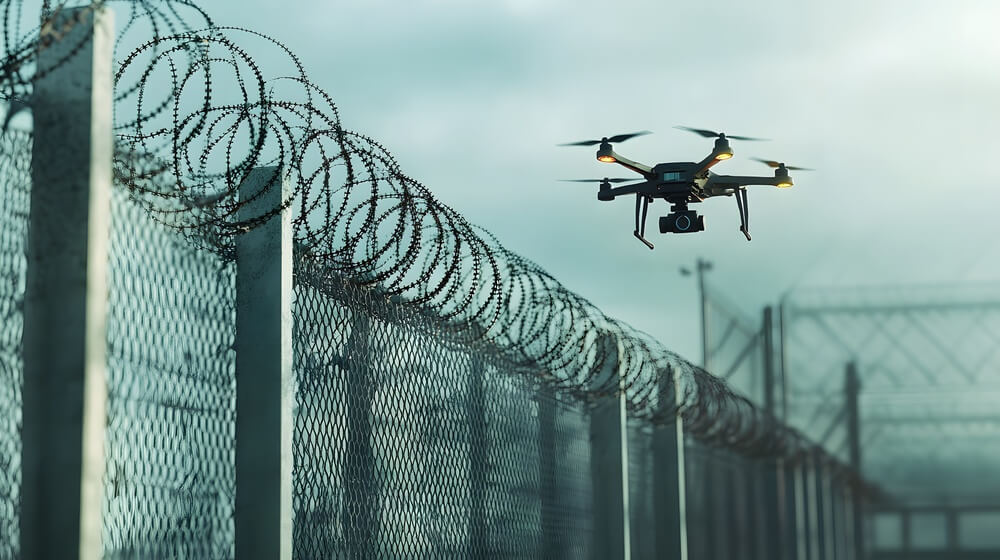The Rising Threat of Drones in Correctional Facilities
The use of drones for smuggling contraband into correctional facilities has become an alarming issue, posing significant security threats to prisons worldwide. These unmanned aerial vehicles (UAVs) have revolutionized the way illicit goods are delivered, bypassing traditional security measures and creating new challenges for prison authorities. Drones can easily transport small packages containing drugs, mobile phones, weapons, and other prohibited items directly into prison yards with remarkable precision. This technological advancement has made it more difficult for correctional facilities to maintain control and safety within their walls, necessitating a closer examination of drone contraband prevention in prisons.
The challenge lies not only in intercepting these UAVs, but also in detecting their presence before they can complete their missions. UAV detection over correctional facilities is becoming a critical component of modern prison security strategies. By employing sophisticated detection systems, prisons aim to identify and neutralize the drone threat before it breaches the perimeter. These systems often include radar, radio frequency scanners, and advanced camera networks, which together form a comprehensive defense against aerial contraband delivery. As drones keep advancing, the ways to stop them must also improve, making sure correctional facilities can successfully block smuggling efforts and keep both inmates and staff safe.
Innovative Strategies for Drone Contraband Prevention
As the threat of drones in prisons continues to grow, correctional facilities are turning to innovative strategies for drone contraband prevention in prisons to safeguard their environments. One such strategy involves implementing advanced prison anti-drone systems designed to detect, track, and neutralize unauthorized UAVs. These systems utilize a combination of radar technology, RF scanners, and infrared cameras to identify potential threats quickly. Once a drone is detected, countermeasures such as signal jamming or drone capture technology can be deployed to prevent the UAV from completing its mission. This multi-layered approach is very important for maintaining a secure perimeter and preventing contraband from reaching inmates.
Beyond technological solutions, prisons are adopting innovative tactics to combat drone smuggling. This includes training prison staff to recognize drone activity and developing intelligence networks to anticipate and intercept potential drone deliveries. Collaboration with law enforcement agencies and technology partners improves the usefulness of these strategies, allowing for real-time information sharing and coordinated responses to threats. By staying up to date and regularly improving their anti-drone measures, correctional facilities can successfully reduce the risks from UAVs and maintain a safer, more controlled environment for both inmates and staff.
Understanding Prison Anti-Drone Systems
Prison anti-drone systems have become a necessary component in the fight against drone smuggling in correctional facilities. These systems are designed to detect and neutralize UAV threats, thereby enhancing the overall security infrastructure. One of the most critical aspects of these systems is UAV detection over correctional facilities, which employs a variety of technologies to identify unauthorized drones. Common detection methods include radar systems that monitor airspace for unusual activity, as well as radio frequency (RF) scanners that pick up signals emitted by drones. Through advanced machine learning algorithms, these systems can differentiate between legitimate and potentially harmful UAVs.
Once a drone is detected, prison anti-drone systems deploy various neutralization techniques to mitigate the threat. Some of the most effective methods include:
- Signal Jamming: This disrupts the communication between the drone and its operator, often causing the UAV to either hover in place or return to its point of origin.
- Drone Capture Devices: These systems use nets or other mechanical means to physically capture and secure the UAV, preventing it from delivering contraband.
- Geo-fencing: This technology sets virtual boundaries around the facility, automatically alerting authorities if a drone enters the restricted area.
By integrating these technologies, correctional facilities can create a solid defense against drone-related security breaches, ensuring the safety and integrity of their operations.
Future of Drone Threat Management in Prisons
As drone technology continues to advance, so too must the methods for managing these aerial threats within correctional facilities. The future of drone threat management in prisons will likely involve significant technological innovations and policy enhancements aimed at improving drone contraband prevention. One promising area of development is the integration of artificial intelligence and machine learning into UAV detection systems. These technologies could enable more accurate threat identification by analyzing drone flight patterns and distinguishing between benign and malicious activity more successfully. Additionally, advancements in sensor technology and data analytics might provide real-time situational awareness, allowing prison staff to respond more quickly to potential breaches.
On the policy front, regulatory frameworks may evolve to support more proactive approaches in combating UAV threats. This could include international collaborations to standardize anti-drone measures across borders, ensuring a unified response to the growing issue. There might be developments in legislation that empower correctional facilities with greater authority to deploy counter-drone technologies without legal repercussions, thereby strengthening their ability to neutralize threats promptly. As these technological and policy improvements converge, they hold the potential to significantly increase UAV detection over correctional facilities, creating a safer environment that successfully stops the problems caused by unauthorized drones.


Recent Comments